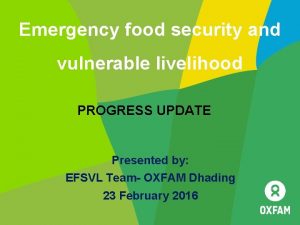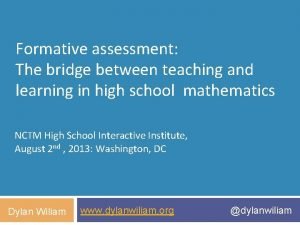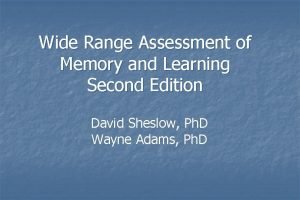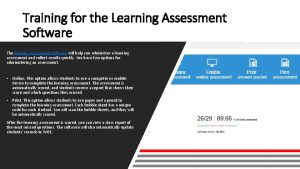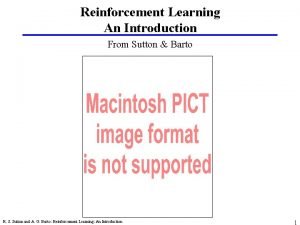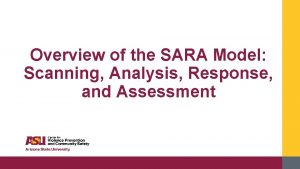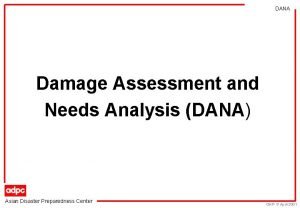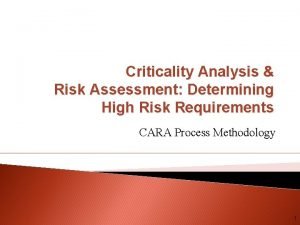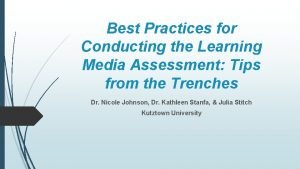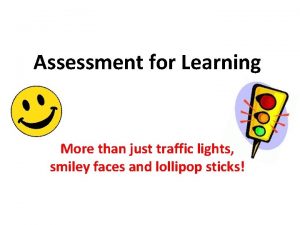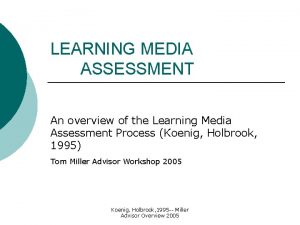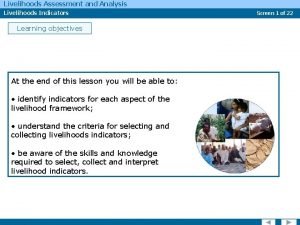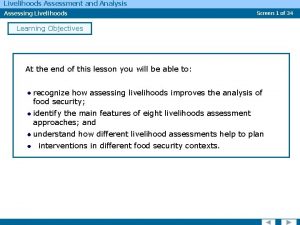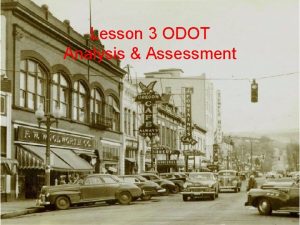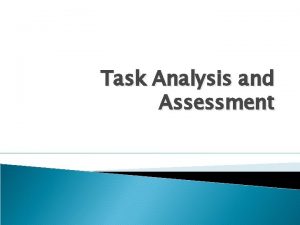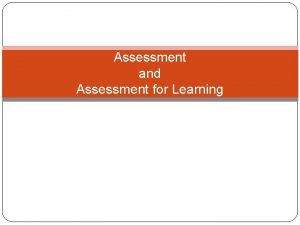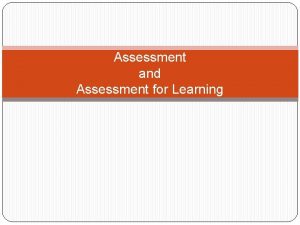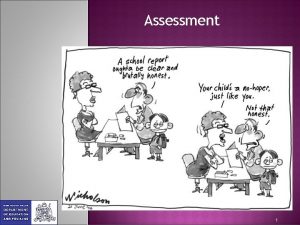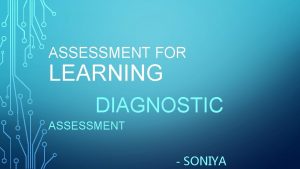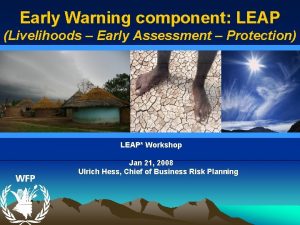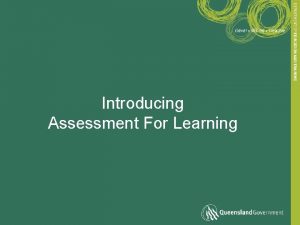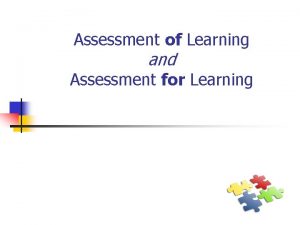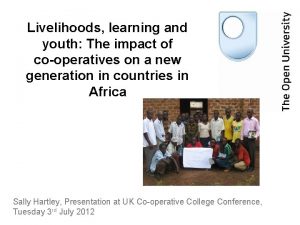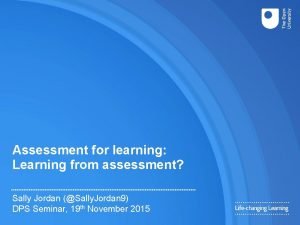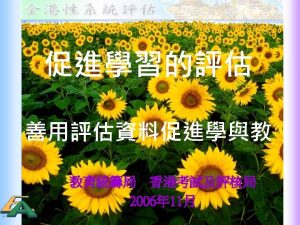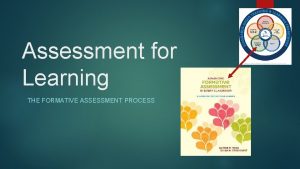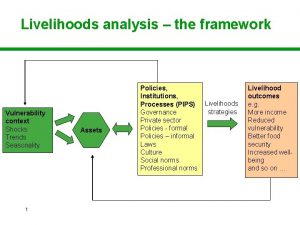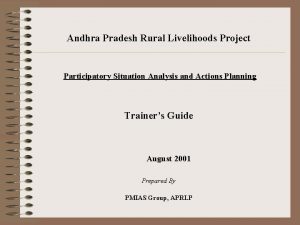Livelihoods Assessment and Analysis Introduction to Livelihoods Learning






















- Slides: 22

Livelihoods Assessment and Analysis Introduction to Livelihoods Learning objectives At the end of this lesson you will be able to: define the concept of livelihoods; identify the livelihoods components in real examples; and understand the role of the market in livelihoods. Screen 1 of 22

Livelihoods Assessment and Analysis Introduction to Livelihoods Screen 2 of 22 Definitions of livelihoods Livelihoods are ‘means of making a living’, the various activities and resources that allow people to live. Definition “Livelihood comprises the capabilities, assets (including both material and social) and activities required for a means of living. (Chambers and Conway, 1992). A livelihood is sustainable when it can: cope with, and recover from stress and shocks (drought, flood, war, etc. ), maintain or enhance its capabilities and assets, while not undermining the natural resource base”.

Livelihoods Assessment and Analysis Introduction to Livelihoods Screen 3 of 22 Definitions of livelihoods Livelihoods are similar for groups of people doing similar things. A “livelihood group” is a group of people who: access similar resources, share similar social and cultural values, and have a comparable economic status.

Livelihoods Assessment and Analysis Introduction to Livelihoods Screen 4 of 22 Components of the livelihoods framework Livelihoods are determined by multiple factors a combination of different types of information is needed to understand them, including: Vulnerability context Livelihood resources or assets Policies, institutions and processes Livelihood strategies Livelihood outcomes or goals

Livelihoods Assessment and Analysis Introduction to Livelihoods Screen 5 of 22 Components of the livelihoods framework Vulnerability context The vulnerability context frames the external environment in which people live. It includes factors over which people have limited or no control: Long-term trend factors Risk of shocks Seasonal elements

Livelihoods Assessment and Analysis Introduction to Livelihoods Screen 6 of 22 Components of the livelihoods framework Vulnerability context It is important to understand the political context in order to understand the vulnerability context. In situations of political instability and war, it is ethnic or political affiliation that determines risk and vulnerability, irrespective of wealth.

Livelihoods Assessment and Analysis Introduction to Livelihoods Screen 7 of 22 Components of the livelihoods framework Livelihood resources or assets People require a range of assets to achieve positive livelihood outcomes: Human assets Social assets Natural assets Physical assets Financial assets These five asset categories are interlinked. No single category on its own is sufficient to yield all the many and varied livelihood outcomes that people seek.

Livelihoods Assessment and Analysis Introduction to Livelihoods Screen 8 of 22 Components of the livelihoods framework Policies, institutions, processes Policies, institutions and processes are man-made external factors that shape the options that people have in achieving their livelihood goals. They: influence access to assets and vulnerability to shocks, operate at all levels, from the local to the international level, operate in all spheres, from the most private to the most public, can be instrumental in increasing or reducing vulnerability to disasters (especially Agricultural, land tenure or land use policies).

Livelihoods Assessment and Analysis Introduction to Livelihoods Screen 9 of 22 Components of the livelihoods framework Policies, institutions, processes Policies (agricultural, land tenure or land use) can be instrumental in increasing or reducing vulnerability to disasters. Institutions include civic, political and economic agencies. People’s protection and welfare depend on: accountable political systems, rule of law, functioning judicial systems, and the provision of public services. Processes determine the way institutions and people operate and interact. They can include: changes in the economy, employment patterns, markets, culture, and long-term processes of social, economic and political marginalization.

Livelihoods Assessment and Analysis Introduction to Livelihoods Screen 10 of 22 Components of the livelihoods framework Livelihood strategies are: the range and combination of activities and choices that people make or undertake in stable times to achieve their livelihood goals (e. g. productive activities, investment strategies, reproductive choices). Livelihood strategies can be divided into: Natural resource-based activities (e. g. cultivation, livestock-keeping, weaving, collection and gathering) Non-natural resource-based activities (e. g. trade, services, remittances).

Livelihoods Assessment and Analysis Introduction to Livelihoods Screen 11 of 22 Components of the livelihoods framework Livelihood strategies Coping strategies, in contrast, are temporary responses to food insecurity (although in many protracted emergencies they become livelihood strategies). Can you think of potential problems arising from the adoption of coping strategies?

Livelihoods Assessment and Analysis Introduction to Livelihoods Screen 12 of 22 Components of the livelihoods framework Livelihood outcomes or goals Livelihood outcomes can be categorized under three headings: Economic Food and income security, i. e. the ability to acquire sufficient food and income to meet basic needs. Biological Mortality and malnutrition rates or levels are biological measures of livelihood outcome. Social Dignity is clearly a social measure: the right to life with dignity is one of the fundamental principles in the Humanitarian Charter.

Livelihoods Assessment and Analysis Introduction to Livelihoods Components of the livelihoods framework Screen 13 of 22 Key H = Human Capital N = Natural Capital F = Financial Capital S = Social Capital P = Physical Capital This framework considers five types of capital - the “asset pentagon”and how these assets are transformed by policies and institutions into livelihoods strategies. Livelihood strategies produce livelihood outcomes The vulnerability context impacts on the livelihood assets

Livelihoods Assessment and Analysis Introduction to Livelihoods Screen 14 of 22 Components of the livelihoods framework Let’s see how a real situation can be ‘read’ using the livelihoods framework. Example: Artisanal fishers in Benin Full-time sedentary fishers in Benin live without land in settled fishing communities on the seacoast, where sandy soil precludes agricultural activity and fishing is the main source of family income. The worst-off in this group own no equipment nor gear, receive very low wages as members of fishing crews and have limited cash to cover basic expenses. Can you identify some of the livelihood components?

Livelihoods Assessment and Analysis Introduction to Livelihoods Screen 15 of 22 Components of the livelihoods framework This example provides information about: vulnerability, assets, and policies/processes/institutions. Example: Pastoralists in southern Somalia • Pastoralists in southern Somalia derive the majority of their food needs from the purchase of cereals, sugar and oil. • Milk and milk products from cattle comprise a significant additional food source. • Income is mainly obtained from sale of livestock and livestock products. • Poorer wealth groups with their smaller herd sizes obtain a significant amount of food/income from activities such as petty trade, bush product collection and casual labour. • Intra-community gifts to the poor, such as lactating livestock, food and cash, are also common. Can you identify some of the livelihood components?

Livelihoods Assessment and Analysis Introduction to Livelihoods Screen 16 of 22 Components of the livelihoods framework This example provides information about: vulnerability, assets, and policies/processes/institutions. Example: Agro-pastoralists in southern Somalia • Agro-pastoralists in southern Somalia derive the majority of their food from their own crop production, livestock milk production and some purchase. • Incomes from the sale of livestock and livestock products, the sale of crops and, for poorer groups, a variety of petty trade, casual labour and collection of bush products. Intra-community redistribution is also important for poorer groups. This livelihood group is highly vulnerable to a combination of natural and man-made factors. Members of this group primarily come from politically and militarily marginal clans and have been amongst the greatest victims of violence since the collapse of Siad Barre’s regime in 1991. A combination of poor rains and harvests, the resulting asset losses (of both food stocks and livestock) and displacement have resulted in largescale food deficits. Can you identify some of the livelihood components?

Livelihoods Assessment and Analysis Introduction to Livelihoods Screen 17 of 22 The role of the market in livelihoods Access to markets and how the market functions can be critical to the success or failure of livelihoods. Rural populations: Very poor households may have higher dependence than richer households. In “normal years” there may still be ‘extraordinary’ needs for income, e. g. for purchasing drugs, funeral expenses, school fees. In “bad years”, when crops fail, rural households may be increasingly forced into the market to acquire food. On page 13 in the Learner Notes, you may find a case study: “How markets can dramatically affect livelihood outcomes in Congo”

Livelihoods Assessment and Analysis Introduction to Livelihoods Screen 18 of 22 The role of the market in livelihoods Urban populations: are almost by definition market dependent (even if most rural households have some involvement in markets as well). may be especially vulnerable to market disruption caused by emergencies, (unless government and parastatals intervene to control market price fluctuations).

Livelihoods Assessment and Analysis Introduction to Livelihoods Screen 19 of 22 The role of the market in livelihoods In emergencies, markets play a fundamental role in livelihoods. The form of market disruption will depend on the type of emergency. Food shortages or surplus asset disposal become apparent through staple price rises and falls in livestock prices. As a result, terms of trade begin to decline, thereby impacting livelihoods. At worst, markets can collapse so that rural and urban populations experience sudden crises and complete lack of access to key foods.

Livelihoods Assessment and Analysis Introduction to Livelihoods Screen 20 of 22 Summary Livelihood means in simple words ‘means of making a living’. In a food security context it refers to people, their capabilities, their assets (both material and social), their income and activities required for a means of living (including ways to obtain food). As livelihoods are determined by multiple factors, a combination of different types of information are needed to understand them. The following are the component of the livelihoods framework: • • • Vulnerability context Livelihood resources or assets Policies, institutions and processes Livelihood strategies Livelihood outcomes or goals The market plays an important role in livelihoods, especially in emergency contexts. Access to markets and how the market functions can be critical to the success or failure of livelihoods.

Livelihoods Assessment and Analysis Introduction to Livelihoods Screen 21 of 22 If you want to know more. . . Online resources • Forum on Operationalizing Sustainable Livelihoods Approaches. Inter-agency Experiences and Lessons. Pontignano (Siena) 7 -11 March 2000 http: //www. fao. org/docrep/x 7749 e 00. htm • DFID Sustainable Livelihoods Guidance Sheets www. livelihoods. org/info_guidancesheets. html • Callens & Seiffert 2002. Methodological Guide: Participatory Appraisal and Analysis of Nutrition and Household Food Security Situations and Interventions from a Livelihoods Perspective http: //www. fao. org/docrep/006/ad 694 e 04. htm • Livelihoods Approaches Compared: A Multi-Agency Review of Current Practice (Karim Hussein, with contributions from the agencies studied. Df. ID, ODI, Oct 2002) http: //portals. wdi. wur. nl/files/docs/ppme/Comparing_SLAs. pdf • A Handbook for trainers on participatory local development http: //www. fao. org/sd/dim_pe 2/pe 2_050301_en. htm • Food Insecurity and Vulnerability in Viet Nam: Profiles of Four Vulnerable Groups [FAO/ESA, 2004] http: //www. fao. org/docrep/007/ae 066 e 00. htm

Livelihoods Assessment and Analysis Introduction to Livelihoods Screen 22 of 22 If you want to know more. . . Additional readings • Corbett. J (1988): Famine and household coping strategies. World Development 16 (9) • Jaspars. S and Shoham. J (2002): A critical review of approaches to assessing and monitoring livelihoods in situations of chronic conflict and political instability. ODI Working Paper 191 • WFP (2005): Emergency Food Security Assessment Handbook • Young. H et al (2001): Food security assessment in emergencies: A livelihoods approach. ODI HPN Network Papers 36. ODI, London • Jaspars. S (2006): From food crisis to fair trade. Livelihoods analysis, protection and support in emergencies. ENN Special Supplement No 3 • Narbeth. S and Mc. Lean. C (2003): Livelihoods and protection. Displacement and vulnerable communities in Kismaayo, southern Somalia. HPN Network paper No 44, December 2003 • Pain. A (2002): Understanding and monitoring livelihoods under conditions of chronic conflict: Lessons from Afghanistan. ODI working paper 187 • Boudreau. T and Coutts. P (2002): Food economy in situations of chronic political instability. ODI working paper 188 • WFP (2003): Key issues in emergency needs assessment. Volume 1: Report of the Technical Meeting. 28 -30 October 2003, Rome, Italy • F. Pittaluga, E. Corcoran, and J. Senahoun: Poverty profiles of artisanal fishers: methods based on the SLA model • Food Insecurity and Vulnerability in Nepal: Profiles of Seven Vulnerable Groups [FAO/ESA, 2004]
 Emergency food security and vulnerable livelihoods
Emergency food security and vulnerable livelihoods Cuadro comparativo de e-learning b-learning y m-learning
Cuadro comparativo de e-learning b-learning y m-learning Assessment the bridge between teaching and learning
Assessment the bridge between teaching and learning Wraml age range
Wraml age range Assessment and learning john gardner
Assessment and learning john gardner La.ldschurch.org/online
La.ldschurch.org/online Inductive and analytical learning
Inductive and analytical learning Inductive and analytical learning problem
Inductive and analytical learning problem Eager learning vs lazy learning
Eager learning vs lazy learning Deep learning approach and surface learning approach
Deep learning approach and surface learning approach Product principle in portfolio assessment
Product principle in portfolio assessment Static assessment vs dynamic assessment
Static assessment vs dynamic assessment Portfolio assessment matches assessment to teaching
Portfolio assessment matches assessment to teaching An introduction to reinforcement learning sutton and barto
An introduction to reinforcement learning sutton and barto Data mining azure
Data mining azure Scanning analysis response assessment
Scanning analysis response assessment Dana asian
Dana asian Criticality analysis and risk assessment
Criticality analysis and risk assessment Learning media assessment
Learning media assessment Traffic lights assessment for learning
Traffic lights assessment for learning Learning media assessment template
Learning media assessment template Igcse teacher training
Igcse teacher training Lifelong learning assessment
Lifelong learning assessment
